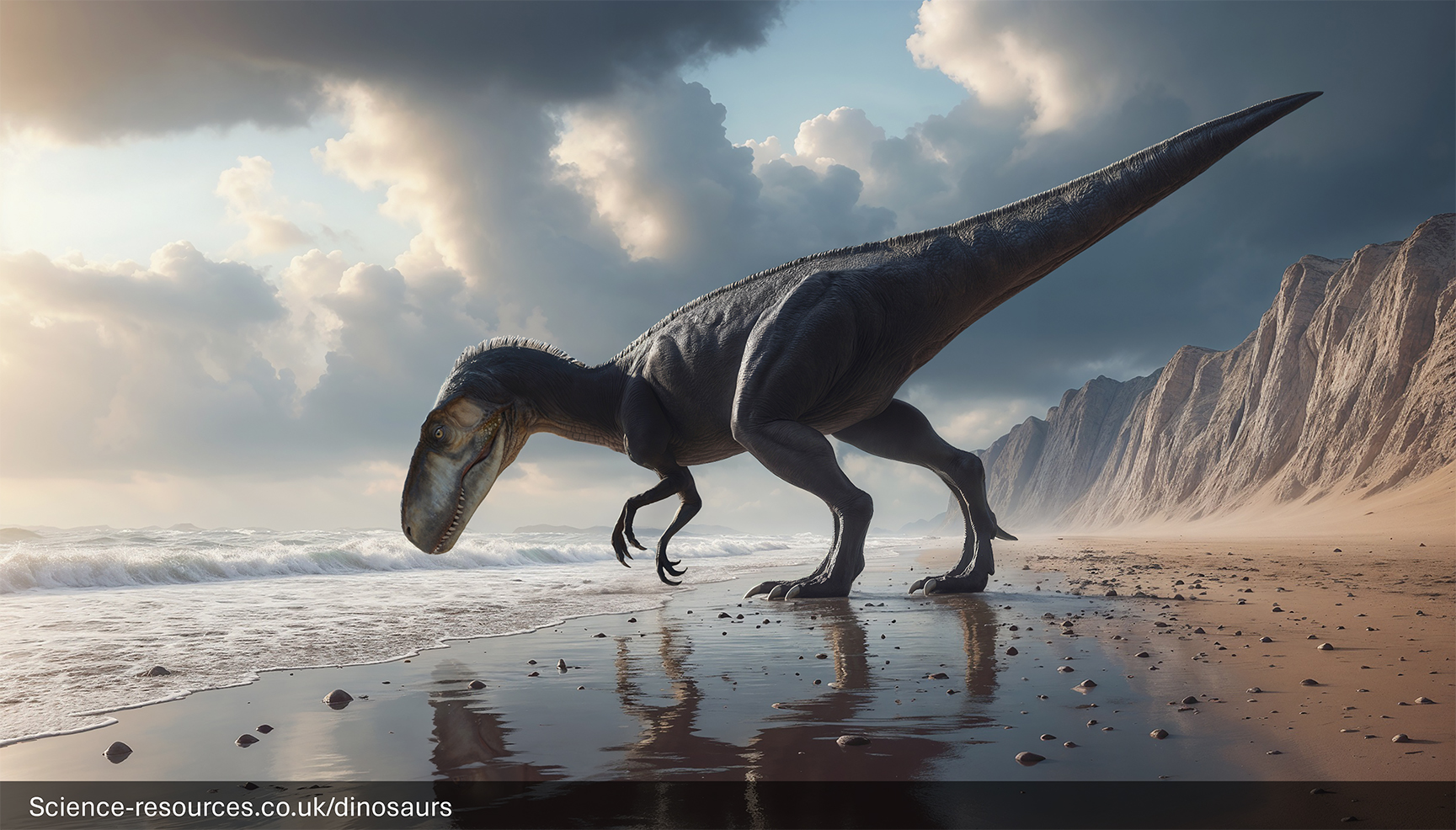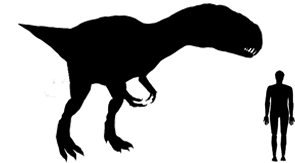Dinosaurs A:Z | E
You may also be intrested in: Free Dinosaur games
Dinosaurs: Eustreptospondylus (Well Curved Vertebrae)
You may also be intrested in: Free Dinosaur games
Last updated: 12th Dec 2024 Eustreptospondylus was a large, meat-eating dinosaur that lived in Europe during the Late Jurassic period, around 164 to 161 million years ago. It inhabited areas that are now part of Europe. Length: Eustreptospondylus could grow up to 7 meters (23 feet) long. Height: Its exact height is unknown, but it likely stood around 2 to 3 meters (6.5 to 10 feet) tall at the hips. Weight: Estimates suggest Eustreptospondylus weighed between 500 kg to 1000 kg. Eustreptospondylus had many unique features that made it a fascinating dinosaur: • Teeth: Sharp, hooked teeth perfect for eating meat. • Arms and claws: Short arms with three-fingered hands, each finger ending in a sharp hooked claw. • Head: A large head with a long, flexible neck. • Body: Lightly built body with powerful hind legs for running and a tail that provided balance. • Vertebrae: Named for its well-curved vertebrae, which gave it a unique backbone structure. Generative AI Notification: Some elements of this image have been created or enhanced using AI technology. To find out how we create all our dinosaurs, click here. Eustreptospondylus was a carnivore, meaning it ate meat. It likely preyed on smaller dinosaurs and may have scavenged dead or dying animals. Eustreptospondylus fossils have been found in England. It lived in areas with forests and open plains, where many plant-eating dinosaurs and other prey roamed. • Meaning of Eustreptospondylus: "Well Curved Vertebrae" – named for its unique backbone structure. • Family: Eustreptospondylus belonged to the Megalosauridae family, a group of large theropod dinosaurs. • Movement: Eustreptospondylus walked on two legs, using its strong hind legs and long tail for balance. • Relative: Scientists believe it was closely related to Megalosaurus. What is Eustreptospondylus?
How big was Eustreptospondylus?
Appearance
 Eustreptospondylus
EustreptospondylusWhat did Eustreptospondylus eat?
Where did Eustreptospondylus live?
Interesting facts
Pronounced: yoo-STREP-toe-spon-DIE-lus


Eustreptospondylus Facts
Name Means: "Well-Curved Vertebrae"
Length: 23 - 30 feet (7 - 9 m)
Height: 10 - 14 feet (3 - 4.5 m)
Weight: 1 ton (900 - 1,000 kg)
Diet: Carnivore (Meat)
Time: Late Jurassic
Habitat: Coastal Woodland
Fossils Found: Europe
Eustreptospondylus belonged to the Megalosauridae family, a group of large theropod dinosaurs. This family also included dinosaurs like Megalosaurus.
Eustreptospondylus was a biped, meaning it walked on two legs. Its strong hind legs and long tail helped it move quickly and maintain balance while running.
The unique curved vertebrae of Eustreptospondylus likely provided it with a flexible neck and enhanced its ability to move and hunt effectively.
Eustreptospondylus had several unique features:
• Teeth: Sharp, hooked teeth for slicing meat.
• Arms and claws: Short arms with sharp, hooked claws for grabbing prey.
• Vertebrae: Distinctive well-curved vertebrae that set it apart from other dinosaurs.
Eustreptospondylus and Allosaurus were both large, bipedal carnivorous dinosaurs, but they belonged to different families. Eustreptospondylus was part of the Megalosauridae family, while Allosaurus belonged to the Allosauridae family.
Q1: What is an Eustreptospondylus?
A1: Eustreptospondylus was a medium-sized, carnivorous dinosaur that lived during the Middle to Late Jurassic Period, around 166-154 million years ago. Its name means "well-curved vertebra".
Q2: How big was the Eustreptospondylus?
A2: Eustreptospondylus could grow up to 23 feet long and weigh around 500-600 pounds. It had a slender body, long tail, and strong legs, making it a fast and agile predator.
Q3: What did Eustreptospondylus eat?
A3: Eustreptospondylus was a carnivore, meaning it ate meat. It likely preyed on smaller dinosaurs and other animals, using its sharp teeth and claws to catch and eat its prey.
Q4: Where did Eustreptospondylus live?
A4: Eustreptospondylus lived in what is now southern England. Fossils have been found in the Oxford Clay Formation, which was a coastal environment during the Jurassic.
Q5: What makes Eustreptospondylus different from other dinosaurs?
A5: Eustreptospondylus is known for its well-curved vertebrae and slender build. It was one of the most complete large theropod skeletons found in Europe from the Jurassic period.
Q6: How did Eustreptospondylus hunt its prey?
A6: Eustreptospondylus likely used its speed and agility to chase down prey. It may have also used ambush tactics, hiding and then quickly attacking its prey with its sharp teeth and claws.
Q7: What did Eustreptospondylus look like?
A7: Eustreptospondylus had a slender body, long tail, and strong legs. It had a mouth full of sharp teeth and its skin was likely covered in scales.
Q8: Why is Eustreptospondylus important to scientists?
A8: Eustreptospondylus provides valuable insights into the evolution of theropod dinosaurs and their adaptations. Its fossils help scientists understand dinosaur behaviour, anatomy, and the environment of the Jurassic.
Q9: Where can I see an Eustreptospondylus skeleton?
A9: You can see Eustreptospondylus skeletons in several museums, including the Natural History Museum in London, where detailed studies of its fossils have been conducted.
Q10: What is the significance of the name Eustreptospondylus?
A10: The name Eustreptospondylus means "well-curved vertebra," reflecting the unique shape of its vertebrae. It was named by paleontologist Alick Donald Walker in 1964.
Which family of Dinosaurs did Eustreptospondylus belong to?
How did Eustreptospondylus move?
Why did Eustreptospondylus have curved vertebrae?
What were the unique features of Eustreptospondylus?
Was Eustreptospondylus related to Allosaurus?
Eustreptospondylus FAQ
You may also be intrested in:
Tags: How big was Eustreptospondylus, Eustreptospondylus size, where does Eustreptospondylus live, how tall are Eustreptospondylus, what does Eustreptospondylus mean, Eustreptospondylus, Eustreptospondylus facts